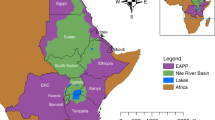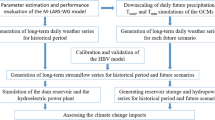Abstract
Climate change is expected to significantly reshape hydropower generation in California. However, the impact on the ability of hydropower to provide reserve capacity that can provide on-demand, back-up electricity generation to stabilize the grid in the case of a contingency has not been explored. This study examined the impact of climate change-driven hydrologic shifts on hydropower contributions to generation and ancillary services. We used projections from four climate models under Representative Concentration Pathways (RCP) RCP4.5 and RCP8.5 to evaluate the impact of climate change conditions, comparing the future period 2046–2055 to the baseline 2000–2009, and observed a net increase of inflow into large hydropower units in northern California. However, as extreme events yield greater spillage, increased overall inflow did not necessarily yield increased generation. Additionally, higher winter generation and summer reservoir constraints resulted in decreases in the spinning reserve potential for both RCP scenarios. We also examined a regionally downscaled “long drought” scenario under RCP8.5 to assess the impact of an extended dry period on generation and spinning reserve bidding. The long drought scenario, developed as part of the California 4th Climate Assessment, involves rainfall congruent with 20-year historical dry spells in California under increased temperatures. In addition to decreased generation, the long drought scenario yielded a 41% reduction in spinning reserve bidding tied to a decline in reservoir levels. The decreased spinning reserve bidding from hydropower may require increased reliance on other electricity resources that can provide the same dynamic support to maintain grid stability under climate change.







Similar content being viewed by others
References
Brekke, Levi, Andy Wood, and Tom Pruitt. 2014. “Downscaled CMIP3 and CMIP5 hydrology projections release of hydrology projections, comparison with preceding information, and summary of user needs.” https://gdo-dcp.ucllnl.org/downscaled_cmip_projections/techmemo/BCSD5HydrologyMemo.pdf
Climate Change Technical Advisory Group. 2015. “Perspectives and guidance for climate change analysis.” California Department of Water Resources. https://water.ca.gov/LegacyFiles/climatechange/docs/2015/Perspectives_Guidance_Climate_Change_Analysis.pdf
California Energy Commission. 2017. “California hydroelectric statistics & data.” http://www.energy.ca.gov/almanac/renewables_data/hydro/
CAISO. 2006. “Spinning reserve and non-spinning reserve.” https://www.caiso.com/Documents/SpinningReserveandNonSpinningReserve.pdf#_blank
CAISO. 2008. “Market issues and performance: 2007 annual report.” https://caiso.com/Documents/2007AnnualReportonMarketIssuesandPerformance.pdf
CAISO. 2017. 2016 annual report on market issues and performance. http://www.caiso.com/Documents/2016AnnualReportonMarketIssuesandPerformance.pdf
CAISO. (n.d.)“OASIS.” http://oasis.caiso.com/mrioasis/logon.do
Cayan DR et al (2008) Climate change scenarios for the California region. Clim Chang 87(S1):21–42
Chang MK, Eichman JD, Mueller F, Samuelsen S (2013) Buffering intermittent renewable power with hydroelectric generation: a case study in California. Appl Energy 112:1–11
Deng S-j, Shen Y, Haibin S (2006) Optimal scheduling of hydro-electric power generation with simultaneous participation in multiple markets. In: 2006 IEEE PES power systems conference and exposition, IEEE, pp 1650–1657
Department of Water Resources. 2017. “California data exchange center.” http://cdec.water.ca.gov/
Diffenbaugh NS, Swain DL, Touma D (2015) Anthropogenic warming has increased drought risk in California. Proc Natl Acad Sci U S A 112(13):3931–3936
Doorman GL, Nygreen B (2002) An integrated model for market pricing of energy and ancillary services. Electr Power Syst Res 61(3):169–177
Ehsani A, Ranjbar AM, Fotuhi-Firuzabad M (2009) A proposed model for co-optimization of energy and reserve in competitive electricity markets. Appl Math Model 33(1):92–109
Electric Power Research Institute. 2013. “Quantifying the value of hydropower in the electric grid: final report.” https://www1.eere.energy.gov/wind/pdfs/epri_value_hydropower_electric_grid.pdf
FERC. 2001. “Addressing the 2000–2001 western energy crisis.” https://www.ferc.gov/industries/electric/indus-act/wec/enron/data-sets.asp
Gaudard L, Romerio F (2014) The future of hydropower in Europe: interconnecting climate, markets and policies. Environmental Science & Policy 37:172–181
Georgakakos AP et al (2012) Value of adaptive water resources management in Northern California under climatic variability and change: reservoir management. J Hydrol 412–413:34–46
Guégan M, Uvo CB, Madani K (2012) Developing a module for estimating climate warming effects on hydropower pricing in California. Energy Policy 42:261–271
Haddeland I, Skaugen T, Lettenmaier DP (2006) Anthropogenic impacts on continental surface water fluxes. Geophys Res Lett 33(8)
Hanasaki N, Kanae S, Oki T (2006) A reservoir operation scheme for global river routing models. J Hydrol 327(1–2):22–41
Hardin E et al (2017) California drought increases CO2 footprint of energy. Sustainable Cities and Society 28:450–452
Hayhoe K et al (2004) Emissions pathways, climate change, and impacts on California. Proc Natl Acad Sci U S A 101(34):12422–12427
IPCC 2013. Climate change 2013 - the physical science basis. Contribution of working group I to the fifth assessment report of the intergovernmental panel on climate change [Stocker, T.F., D. Qin, G. K. Plattner, M. Tignor, S.K. Allen, J. Boschung, A. Nauels, Y. Xia.] ed. Intergovernmental panel on climate change. Cambridge: Cambridge University Press
Knowles N, Dettinger MD, Cayan DR (2006) Trends in snowfall versus rainfall in the Western United States. J Clim 19(18):4545–4559
Kravitz, Raquel. 2017. “Projected climate scenarios selected to represent a range of possible futures in California.” http://docketpublic.energy.ca.gov/PublicDocuments/16-IEPR-04/TN215798_20170207T111409_Projected_Climate_Scenarios_Selected_to_Represent_a_Range_of_Po.pdf
Liang X, Lettenmaier DP, Wood EF, Burges SJ (1994) A simple hydrologically based model of land surface water and energy fluxes for general circulation models. J Geophys Res 99(D7):14415
Loose, Verne W. 2011. “Quantifying the value of hydropower in the electric grid: role of hydropower in existing markets.” Sandia Laboratories
Madani K, Guégan M, Uvo CB (2014) Climate change impacts on high-elevation hydroelectricity in California. J Hydrol 510:153–163
Maurer EP et al (2007) Detection, attribution, and sensitivity of trends toward earlier streamflow in the Sierra Nevada. J Geophys Res 112(D11):D11118
Maurer EP, Duffy PB (2005) Uncertainty in projections of streamflow changes due to climate change in California. Geophys Res Lett 32(3):L03704
Medellín-Azuara J et al (2008) Adaptability and adaptations of California’s water supply system to dry climate warming. Clim Chang 87(S1):75–90
Null, S.E., and J.H. Viers. 2012. “Water and energy sector vulnerability to climate warming in the Sierra Nevada: water year classification in non-stationary climates.” California Energy Commission (CEC-500-2012-015)
Pierce DW, Cayan DR, Thrasher BL (2014) Statistical downscaling using localized constructed analogs (LOCA). J Hydrometeorol 15(6):2558–2585
Stewart IT, Cayan DR, Dettinger MD (2005) Changes toward earlier streamflow timing across Western North America. J Clim 18(8):1136–1155
Tanaka SK et al (2006) Climate warming and water management adaptation for California. Clim Chang 76(3–4):361–387
Tarroja B et al (2014) Evaluating options for balancing the water-electricity Nexus in California: part 2–greenhouse gas and renewable energy utilization impacts. Sci Total Environ 497–498:711–724
Tarroja B, AghaKouchak A, Samuelsen S (2016) Quantifying climate change impacts on hydropower generation and implications on electric grid greenhouse gas emissions and operation. Energy 111:295–305
U.S. Bureau of Reclamation. (n.d.) “New melones unit project.” https://www.usbr.gov/projects/index.php?id=365
U.S. Energy Information Administration. 2014. “California drought leads to less hydropower, increased natural gas generation - today in energy - U.S. Energy Information Administration (EIA).” https://www.eia.gov/todayinenergy/detail.php?id=18271
US Geological Survey California Water Science Center. 2011. “Water data: annual data reports.” https://ca.water.usgs.gov/data/waterdata/schematics2007.html
USGS Water Resources. 2017. “National Water information system.” https://waterdata.usgs.gov/nwis
van Beek LPH, Wada Y, Bierkens MFP (2011) Global monthly water stress: 1. Water balance and water availability. Water Resour Res 47(7)
Vicuna S et al (2008) Climate change impacts on high elevation hydropower generation in California’s Sierra Nevada: a case study in the upper American River. Clim Chang 87(1):123–137
Vicuna S, Dracup JA (2007) The evolution of climate change impact studies on hydrology and water resources in California. Clim Chang 82(3):327–350
Vicuña S, Dracup JA, Dale L (2011) Climate change impacts on two high-elevation hydropower systems in California. Clim Chang 109(1):151–169
Vine E (2012) Adaptation of California’s electricity sector to climate change. Clim Chang 111(1):75–99
Zhu T, Jenkins MW, Lund JR (2005) Estimated impacts of climate warming on California water availability under twelve future climate scenarios. J Am Water Resour Assoc 41(5):1027–1038
Acknowledgments
We acknowledge the World Climate Research Programme’s Working Group on Coupled Modelling, which is responsible for CMIP, and we thank the climate modeling groups (listed in Table S4) for producing and making their model output available. For CMIP, the U.S. Department of Energy’s Program for Climate Model Diagnosis and Intercomparison provided coordinating support and led development of software infrastructure in partnership with the Global Organization for Earth System Science Portals.
The California Map used in this article was created using ArcGIS® software by Esri. ArcGIS® and ArcMap™ is the intellectual property of Esri and is used herein under license. Copyright © Esri. All rights reserved. For more information about Esri® software, please visit www.esri.com.
Funding
The authors acknowledge the California Energy Commission for providing funding for this work under the Long-Term Climate Scenarios project, Agreement #: EPC-14-074.
Author information
Authors and Affiliations
Corresponding author
Additional information
Publisher’s Note
Springer Nature remains neutral with regard to jurisdictional claims in published maps and institutional affiliations.
Electronic supplementary material
ESM 1
(DOCX 6565 kb)
Rights and permissions
About this article
Cite this article
Forrest, K., Tarroja, B., Chiang, F. et al. Assessing climate change impacts on California hydropower generation and ancillary services provision. Climatic Change 151, 395–412 (2018). https://doi.org/10.1007/s10584-018-2329-5
Received:
Accepted:
Published:
Issue Date:
DOI: https://doi.org/10.1007/s10584-018-2329-5




